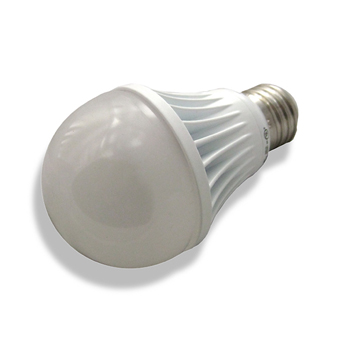Between CFL bulbs and LED bulbs??
led bulb im talking about
There are two key terms pertaining to light bulbs: watts and lumens. A watt refers to the amount of energy required to power a bulb. With incandescent bulbs, the number of watts has become synonymous with the level of brightness, even though a watt really does not tell you anything more than the amount of power necessary to light the bulb. Lumens, on the other hand, indicate the actual amount of light emitted by the bulb. For example, a typical incandescent 40W light bulb draws 40 watts of power and provides about 400 lumens of brightness. A CFL requires 9-13 watts and an LED light bulb uses 6-7 watts to provide the same amount of lumens.

Until recently, most homes used incandescent light bulbs. Incandescent bulbs emit light by generating heat. Unfortunately 90% of the power required to provide the desired brightness is emitted in heat rather than visible light. For this reason, incandescent bulbs are gradually being phased out, and in the United States will be banned entirely by 2014. CFLs have been touted enthusiastically in the past decade, but LEDs are beginning to surpass them because they require as little as half the power and last 10 times longer than a CFL. The table below contrasts the three technologies.
*30 Incandescent Bulbs per Year Equivalent
As you can see, LED light bulbs outperform CFLs in almost every category, and you recover any initial cost investment relatively quickly. In less than a year, you will have recouped your original investment and your savings will begin to accrue rapidly. While installing LED fixtures is an excellent way to go green, you can also use replacement LED light bulbs in your existing fixtures. Either way, you will have energy-efficient, attractive light that will save you money as well as help conserve the environment for years to come.
Source: Elemental LED
Jessica Sullivan is a freelance writer in Los Angeles who cares deeply about environmental conservation and preservation.
led bulb im talking about
There are two key terms pertaining to light bulbs: watts and lumens. A watt refers to the amount of energy required to power a bulb. With incandescent bulbs, the number of watts has become synonymous with the level of brightness, even though a watt really does not tell you anything more than the amount of power necessary to light the bulb. Lumens, on the other hand, indicate the actual amount of light emitted by the bulb. For example, a typical incandescent 40W light bulb draws 40 watts of power and provides about 400 lumens of brightness. A CFL requires 9-13 watts and an LED light bulb uses 6-7 watts to provide the same amount of lumens.

Until recently, most homes used incandescent light bulbs. Incandescent bulbs emit light by generating heat. Unfortunately 90% of the power required to provide the desired brightness is emitted in heat rather than visible light. For this reason, incandescent bulbs are gradually being phased out, and in the United States will be banned entirely by 2014. CFLs have been touted enthusiastically in the past decade, but LEDs are beginning to surpass them because they require as little as half the power and last 10 times longer than a CFL. The table below contrasts the three technologies.
| Incandescent | CFL | LED | |
| Life Span | 1,000 hours | 6,000 | 50,000 hours |
| Watts | 40W | 9W | 6W |
| Lumens | 400 | 320 | 300 |
| Heat Emitted | 56.6 BTUs per hour | 20.3 BTUs per hour | 2.3 BTUs per hour |
| CO2 Emissions | 3000 pounds per year | 701 pounds per year | 301 pounds per year |
| Contains Mercury | No | Yes | No |
| RoHS Compliant | Yes | No | Yes |
| Kilowatts of Electricity Used* | 2190 KWh per year | 531 KWh per year | 228 KWh per year |
| Annual Operating Cost* | $219.06 per year | $53.06 per year | $22.76 per year |
| Cost of Bulb | $0.84 | $2.49 (average) | $24.99 |
| Months to Recover Initial Expense | N/A | Vs. Incandescent: <1 month | Vs. Incandescent: 1.5 months Vs. CFL: 9 months |
As you can see, LED light bulbs outperform CFLs in almost every category, and you recover any initial cost investment relatively quickly. In less than a year, you will have recouped your original investment and your savings will begin to accrue rapidly. While installing LED fixtures is an excellent way to go green, you can also use replacement LED light bulbs in your existing fixtures. Either way, you will have energy-efficient, attractive light that will save you money as well as help conserve the environment for years to come.
Source: Elemental LED
Jessica Sullivan is a freelance writer in Los Angeles who cares deeply about environmental conservation and preservation.



